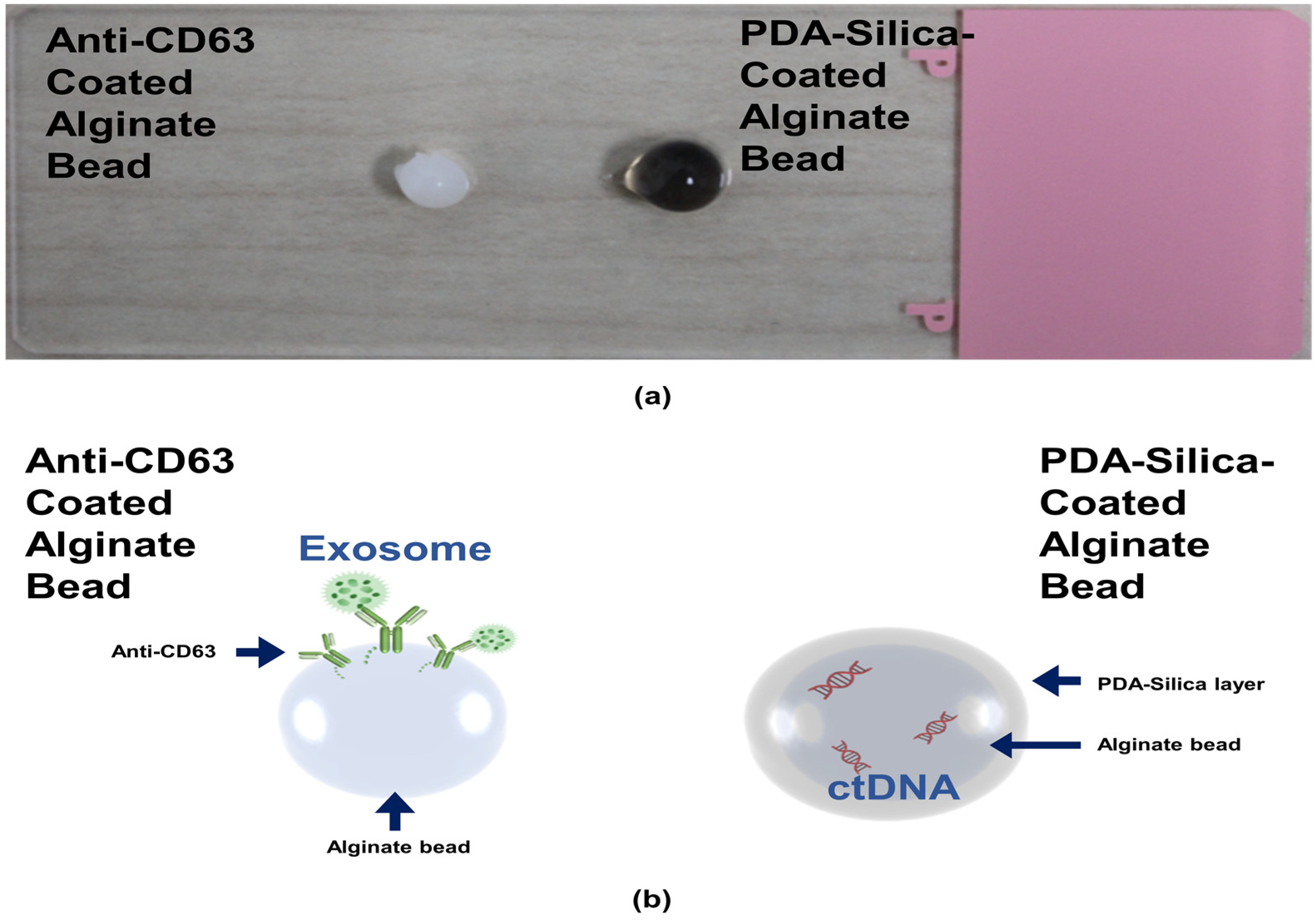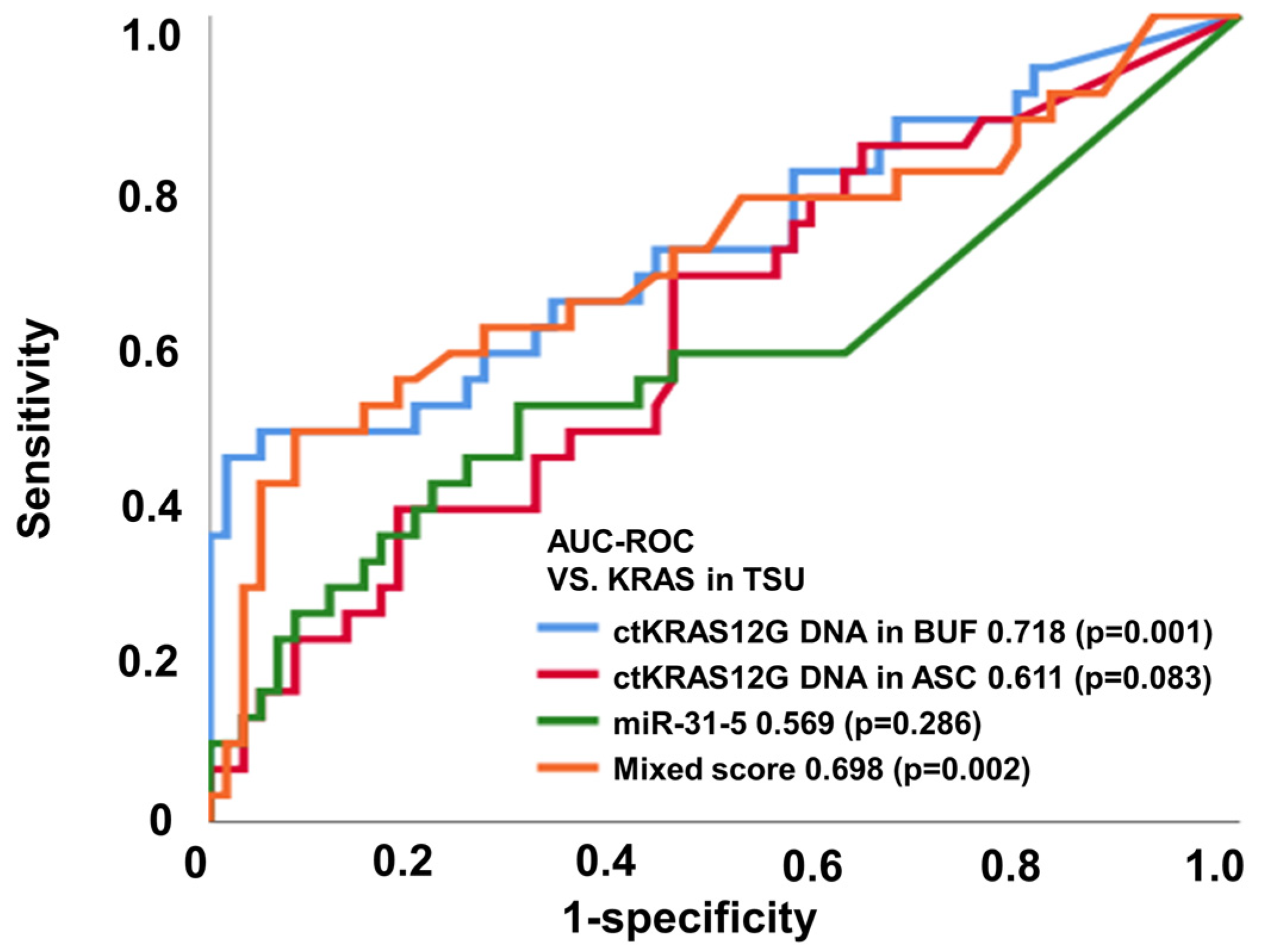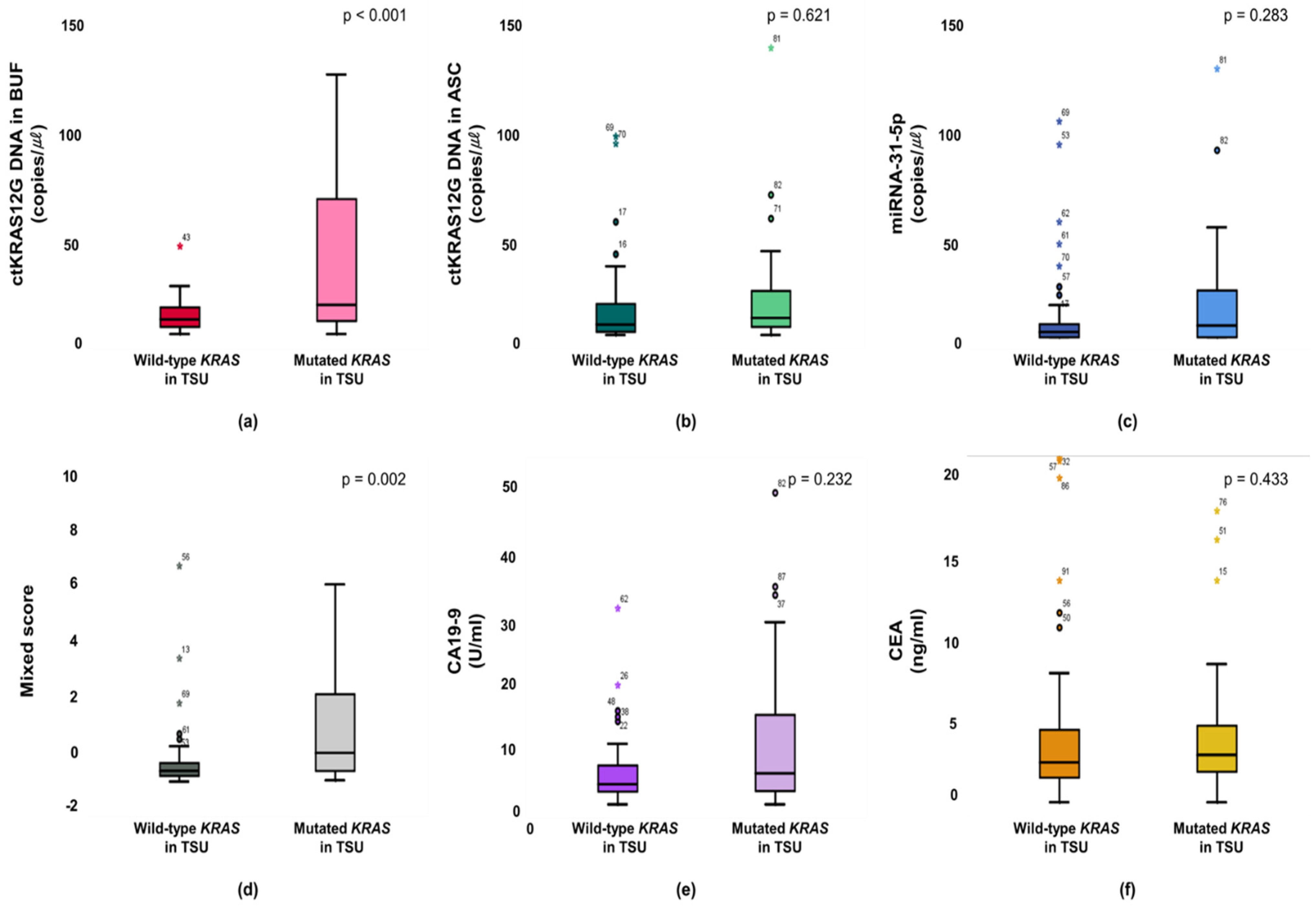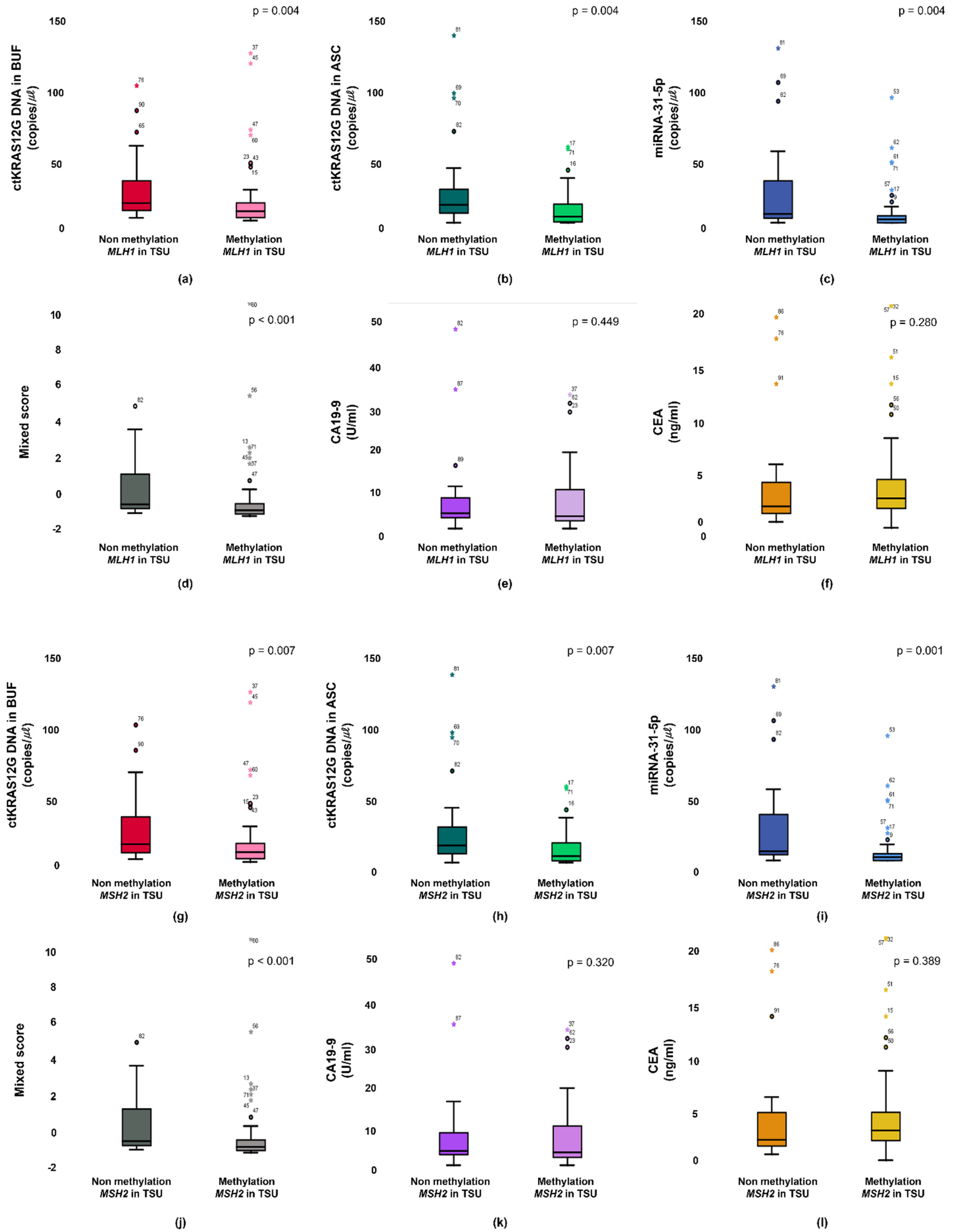The Specific Gravity-Free Method for the Isolation of Circulating Tumor KRAS Mutant DNA and Exosome in Colorectal Cancer
Abstract
:1. Introduction
2. Materials and Methods
2.1. Preparation of the Coated Alginate Bead of PDA–Silica and Anti-CD63
2.2. Surface Characterization Using SEM/EDS
2.3. Isolation of Circulating Tumor DNA (ctDNA) and Exosome
2.4. Droplet Digital PCR Workflow
2.5. Statistics
3. Results
3.1. Immobilized Alginate Bead for ctDNA Absorption and Exosome Isolation
3.2. Clinical Characterization in CRC Patients
3.3. The Diagnostic Capability of ctKRAS G12D Mutation and miR-31-5 from CRC Patients
3.4. Liquid Biopsy of the Buffy Coat, Ascites, and Exosome Correlate with Primary Tumor Status
4. Conclusions
Supplementary Materials
Author Contributions
Funding
Institutional Review Board Statement
Informed Consent Statement
Data Availability Statement
Conflicts of Interest
References
- Lynch, M.L.; Brand, M.I. Preoperative evaluation and oncologic principles of colon cancer surgery. Clin. Colon. Rectal. Surg. 2005, 18, 163–173. [Google Scholar] [CrossRef]
- Underwood, J.J.; Quadri, R.S.; Kalva, S.P.; Shah, H.; Sanjeevaiah, A.R.; Beg, M.S.; Sutphin, P.D. Liquid Biopsy for Cancer: Review and Implications for the Radiologist. Radiology 2020, 294, 5–17. [Google Scholar] [CrossRef] [PubMed]
- Jia, S.; Zhang, R.; Li, Z.; Li, J. Clinical and biological significance of circulating tumor cells, circulating tumor DNA, and exosomes as biomarkers in colorectal cancer. Oncotarget 2017, 18, 55632–55645. [Google Scholar] [CrossRef] [PubMed]
- Bu, J.; Shim, J.E.; Lee, T.H.; Cho, Y.H. Multi-modal liquid biopsy platform for cancer screening: Screening both cancer-associated rare cells and cancer cell-derived vesicles on the fabric filters for a reliable liquid biopsy analysis. Nano Converg. 2019, 6, 39. [Google Scholar] [CrossRef]
- Zhou, B.; Xu, K.; Zheng, X.; Chen, T.; Wang, J.; Song, Y.; Shao, Y.; Zheng, S. Application of exosomes as liquid biopsy in clinical diagnosis. Sig. Transduct. Target Ther. 2020, 5, 144. [Google Scholar] [CrossRef]
- Ribeiro, I.P.; de Melo, J.B.; Carreira, I.M. Head and Neck Cancer: Searching for Genomic and Epigenetic Biomarkers in Body Fluid—The State of Art. Mol. Cytogenet. 2019, 12, 33. [Google Scholar] [CrossRef]
- Palmirotta, R.; Lovero, D.; Cafforio, P.; Felici, C.; Mannavola, F.; Pellè, E.; Quaresmini, D.; Tucci, M.; Silvestris, F. Liquid biopsy of cancer: A multimodal diagnostic tool in clinical oncology. Ther. Adv. Med. Oncol. 2018, 10. [Google Scholar] [CrossRef]
- Lundberg, I.V.; Wikberg, M.L.; Ljuslinder, I.; Li, X.; Myte, R.; Zingmark, C.; Löfgren-Burström, A.; Edin, S.; Palmqvist, R. MicroRNA Expression in KRAS- and BRAF-mutated Colorectal Cancers. Anticancer Res. 2018, 38, 677–683. [Google Scholar] [CrossRef] [PubMed]
- Zlobec, I.; Kovac, M.; Erzberger, P.; Molinari, F.; Bihl, M.P.; Rufle, A.; Foerster, A.; Frattini, M.; Terracciano, L.; Heinimann, K.; et al. Combined analysis of specific KRAS mutation, BRAF and microsatellite instability identifies prognostic subgroups of sporadic and hereditary colorectal cancer. Int. J. Cancer 2010, 127, 2569–2575. [Google Scholar] [CrossRef]
- Neumann, J.; Zeindl-Eberhart, E.; Kirchner, T.; Jung, A. Frequency and type of KRAS mutations in routine diagnostic analysis of metastatic colorectal cancer. Pathol. Res. Pract. 2009, 205, 858–862. [Google Scholar] [CrossRef] [PubMed]
- Vautrot, V.; Chanteloup, G.; Elmallah, M.; Cordonnier, M.; Aubin, F.; Garrido, C.; Gobbo, J. Exosomal miRNA: Small Molecules, Big Impact in Colorectal Cancer. J. Oncol. 2019, 2019, 8585276. [Google Scholar] [CrossRef]
- Bu, J.; Lee, T.H.; Jeong, W.-J.; Poellmann, M.J.; Mudd, K.; Eun, H.S.; Hyun, S.H. Enhanced detection of cell-free DNA (cfDNA) enables its use as a reliable biomarker for diagnosis and prognosis of gastric cancer. PLoS ONE 2020, 15, e0242145. [Google Scholar] [CrossRef] [PubMed]
- Bajpai, S.; Sharma, S. Sharma S Investigation of swelling/degradation behaviour of alginate beads crosslinked with Ca2+ and Ba2+ ions. React. Funct. Polym. 2004, 59, 129–140. [Google Scholar] [CrossRef]
- Lee, H.A.; Park, E.; Lee, H. Polydopamine and Its Derivative Surface Chemistry in Material Science: A Focused Review for Studies at KAIST. Adv. Mater. 2020, 32, 1907505. [Google Scholar] [CrossRef] [PubMed]
- Xi, Z.-Y.; Xu, Y.-Y.; Zhu, L.-P.; Wang, Y.; Zhu, B.-K. A facile method of surface modification for hydrophobic polymer membranes based on the adhesive behavior of poly(DOPA) and poly(dopamine). J. Membr. Sci. 2009, 327, 244–253. [Google Scholar] [CrossRef]
- Doyle, L.M.; Wang, M.Z. Overview of Extracellular Vesicles, Their Origin, Composition, Purpose, and Methods for Exosome Isolation and Analysis. Cells 2019, 8, 727. [Google Scholar] [CrossRef]
- Lee, B.; Lipton, L.; Cohen, J.; Tie, J.; Javed, A.A.; Li, L.; Goldstein, D.; Tomasetti, C.; Papadopoulos, N.; Kinzler, K.W.; et al. Circulating tumor DNA as a potential marker of adjuvant chemotherapy benefit following surgery for localized pancreatic cancer. Ann. Oncol. 2019, 30, 1472–1478. [Google Scholar] [CrossRef]
- Tarazona, N.; Gimeno-Valiente, F.; Gambardella, V.; Zuñiga, S.; Rentero-Garrido, P.; Huerta, M.; Roselló, S.; Martinez-Ciarpaglini, C.; Carbonell-Asins, J.A.; Carrasco, F.; et al. Targeted next-generation sequencing of circulating-tumor DNA for tracking minimal residual disease in localized colon cancer. Ann. Oncol. 2019, 30, 1804–1812. [Google Scholar] [CrossRef]
- De Roock, W.; Claes, B.; Bernasconi, D.; De Schutter, J.; Biesmans, B.; Fountzilas, G.; Tejpar, S. Effects of KRAS, BRAF, NRAS, and PIK3CA mutations on the efficacy of cetuximab plus chemotherapy in chemotherapy-refractory metastatic colorectal cancer: A retrospective consortium analysis. Lancet Oncol. 2010, 11, 753–762. [Google Scholar] [CrossRef]
- Li, W.; Qiu, T.; Dong, L.; Zhang, F.; Guo, L.; Ying, J. Prevalence and characteristics of PIK3CA mutation in mismatch repair-deficient colorectal cancer. J. Cancer 2020, 11, 3827–3833. [Google Scholar] [CrossRef] [PubMed]
- Ogura, T.; Kakuta, M.; Yatsuoka, T.; Nishimura, Y.; Sakamoto, H.; Yamaguchi, K.; Akagi, K. Clinicopathological characteristics and prognostic impact of colorectal cancers with NRAS mutations. Oncol. Rep. 2014, 32, 50–56. [Google Scholar] [CrossRef] [PubMed]





| KRAS mutant type in tissue vs. KRAS wild type in tissue | BRAF mutant type in tissue vs. BRAF wild type in tissue | ||||
| Variables | Pairwise comparison of AUROC (95% CI) | p value | Variables | Pairwise comparison of AUROC (95% CI) | p value |
| ctKRAS DNA mutant in buffy coat | 0.718 (0.598-0.838) | 0.001 | ctKRAS DNA mutant in buffy coat | 0.540 (0.376-0.704) | 0.786 |
| ctKRAS DNA mutant in ascite | 0.611 (0.489-0.734) | 0.083 | ctKRAS DNA mutant in ascite | 0.193 (0.048-0.337) | 0.038 |
| miR-31-5 in exosome | 0.569 (0.434-0.703) | 0.286 | miR-31-5 in exosome | 0.293 (0.170-0.415) | 0.002 |
| Mixed score | 0.698 (0.575-0.822) | 0.002 | Mixed score | 0.269 (0.165-0.374) | 0.001 |
| MLH1 methylation in tissue vs. no MLH1 methylation in tissue | MSH2 methylation in tissue vs. no MSH2 methylation in tissue | ||||
| Variables | Pairwise comparison of AUROC (95% CI) | p value | Variables | Pairwise comparison of AUROC (95% CI) | p value |
| ctKRAS DNA mutant in buffy coat | 0.300 (0.186-0.414) | 0.003 | ctKRAS DNA mutant in buffy coat | 0.314 (0.197-0.430) | 0.006 |
| ctKRAS DNA mutant in ascite | 0.277 (0.168-0.387) | 0.001 | ctKRAS DNA mutant in ascite | 0.286 (0.174-0.398) | 0.002 |
| miR-31-5 in exosome | 0.293 (0.170-0.415) | 0.002 | miR-31-5 in exosome | 0.272 (0.152-0.392) | 0.001 |
| Mixed score | 0.269 (0.165-0.374) | 0.001 | Mixed score | 0.275 (0.169-0.381) | 0.001 |
Publisher’s Note: MDPI stays neutral with regard to jurisdictional claims in published maps and institutional affiliations. |
© 2021 by the authors. Licensee MDPI, Basel, Switzerland. This article is an open access article distributed under the terms and conditions of the Creative Commons Attribution (CC BY) license (https://creativecommons.org/licenses/by/4.0/).
Share and Cite
Lee, T.H.; Park, E.; Goh, Y.-g.; Lee, H.B.; Rou, W.S.; Eun, H.S. The Specific Gravity-Free Method for the Isolation of Circulating Tumor KRAS Mutant DNA and Exosome in Colorectal Cancer. Micromachines 2021, 12, 987. https://doi.org/10.3390/mi12080987
Lee TH, Park E, Goh Y-g, Lee HB, Rou WS, Eun HS. The Specific Gravity-Free Method for the Isolation of Circulating Tumor KRAS Mutant DNA and Exosome in Colorectal Cancer. Micromachines. 2021; 12(8):987. https://doi.org/10.3390/mi12080987
Chicago/Turabian StyleLee, Tae Hee, Eunsook Park, Young-gon Goh, Han Byul Lee, Woo Sun Rou, and Hyuk Soo Eun. 2021. "The Specific Gravity-Free Method for the Isolation of Circulating Tumor KRAS Mutant DNA and Exosome in Colorectal Cancer" Micromachines 12, no. 8: 987. https://doi.org/10.3390/mi12080987
APA StyleLee, T. H., Park, E., Goh, Y.-g., Lee, H. B., Rou, W. S., & Eun, H. S. (2021). The Specific Gravity-Free Method for the Isolation of Circulating Tumor KRAS Mutant DNA and Exosome in Colorectal Cancer. Micromachines, 12(8), 987. https://doi.org/10.3390/mi12080987






